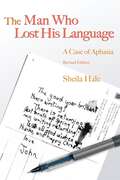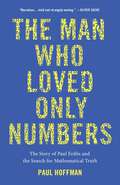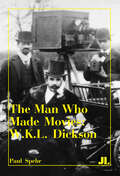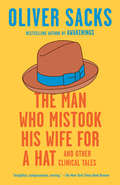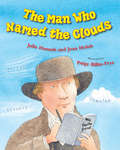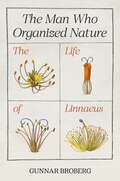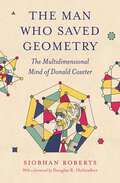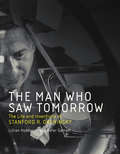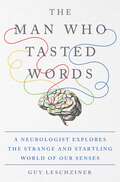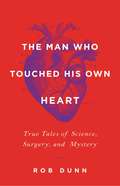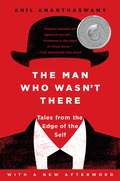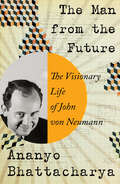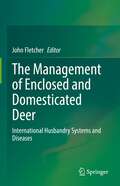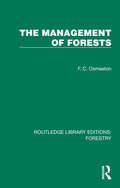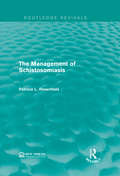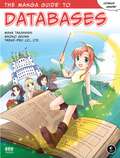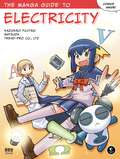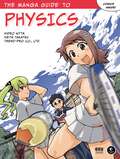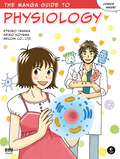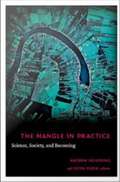- Table View
- List View
The Man Who Lost his Language: A Case of Aphasia Revised Edition
by Sheila HaleThe Man who Lost His Language is a unique exploration of aphasia - losing the ability to use or comprehend words - as well as of the resilience of love. When Sir John Hale suffered a stroke that left him unable to walk, write or speak, his wife, Shelia, followed every available medical trail seeking knowledge of his condition and how he might be restored to health. This revised edition of a classic book includes an additional chapter detailing the latest developments in science and medicine since the first edition was published. This personal account of one couple's experience will be of interest to all those who want to know more about aphasia and related conditions.
The Man Who Loved Only Numbers: The Story of Paul Erdos and the Search for Mathematical Truth
by Paul Hoffman"A funny, marvelously readable portrait of one of the most brilliant and eccentric men in history." --The Seattle Times Paul Erdos was an amazing and prolific mathematician whose life as a world-wandering numerical nomad was legendary. He published almost 1500 scholarly papers before his death in 1996, and he probably thought more about math problems than anyone in history. Like a traveling salesman offering his thoughts as wares, Erdos would show up on the doorstep of one mathematician or another and announce, "My brain is open." After working through a problem, he'd move on to the next place, the next solution. Hoffman's book, like Sylvia Nasar's biography of John Nash, A Beautiful Mind, reveals a genius's life that transcended the merely quirky. But Erdos's brand of madness was joyful, unlike Nash's despairing schizophrenia. Erdos never tried to dilute his obsessive passion for numbers with ordinary emotional interactions, thus avoiding hurting the people around him, as Nash did. Oliver Sacks writes of Erdos: "A mathematical genius of the first order, Paul Erdos was totally obsessed with his subject--he thought and wrote mathematics for nineteen hours a day until the day he died. He traveled constantly, living out of a plastic bag, and had no interest in food, sex, companionship, art--all that is usually indispensable to a human life."The Man Who Loved Only Numbers is easy to love, despite his strangeness. It's hard not to have affection for someone who referred to children as "epsilons," from the Greek letter used to represent small quantities in mathematics; a man whose epitaph for himself read, "Finally I am becoming stupider no more"; and whose only really necessary tool to do his work was a quiet and open mind. Hoffman, who followed and spoke with Erdos over the last 10 years of his life, introduces us to an undeniably odd, yet pure and joyful, man who loved numbers more than he loved God--whom he referred to as SF, for Supreme Fascist. He was often misunderstood, and he certainly annoyed people sometimes, but Paul Erdos is no doubt missed. --Therese Littleton
The Man Who Made Movies: W.K.L. Dickson
by Paul SpehrThe story of W.K.L. Dickson—assistant to Edison, inventor, and key figure in early cinematography: “Valuable and comprehensive.” —Communication Booknotes QuarterlyW.K.L. Dickson was Thomas Edison’s assistant in charge of the experimentation that led to the Kinetoscope and Kinetograph—the first commercially successful moving image machines. In 1891–1892, he established what we know today as the 35mm format. Dickson also designed the Black Maria film studio and facilities to develop and print film, and supervised production of more than one hundred films for Edison.After leaving Edison, he became a founding member of the American Mutoscope Company, which later became the American Mutoscope & Biograph, then Biograph. In 1897, he went to England to set up the European branch of the company. Over the course of his career, Dickson made between five hundred and seven hundred films, which are studied today by scholars of the early cinema. This well-illustrated book offers a window onto early film history from the perspective of Dickson’s own oeuvre.
The Man Who Mistook His Wife for a Hat: And Other Clinical Tales
by Oliver SacksIn his most beloved and extraordinary book, Dr. Sacks recounts the case histories of patients inhabiting the compelling world of neurological disorders. Featuring a preface never before included.Oliver Sacks's The Man Who Mistook His Wife for a Hat tells the stories of individuals afflicted with perceptual and intellectual disorders: patients who have lost their memories and with them the greater part of their pasts; who are no longer able to recognize people and common objects; whose limbs seem alien to them; who lack some skills yet are gifted with uncanny artistic or mathematical talents. In Dr. Sacks's splendid and sympathetic telling, his patients are deeply human, and his tales are studies of struggles against incredible adversity. A great healer, Sacks never loses sight of medicine's ultimate responsibility: "the suffering, afflicted, fighting human subject."
The Man Who Mistook His Wife for a Hat: And Other Clinical Tales
by Oliver SacksIn his most extraordinary book, the bestselling author of Awakenings and "poet laureate of medicine&” (The New York Times) recounts the case histories of patients inhabiting the compelling world of neurological disorders, from those who are no longer able to recognize common objects to those who gain extraordinary new skills.Featuring a new preface, Oliver Sacks&’s The Man Who Mistook His Wife for a Hat tells the stories of individuals afflicted with perceptual and intellectual disorders: patients who have lost their memories and with them the greater part of their pasts; who are no longer able to recognize people and common objects; whose limbs seem alien to them; who lack some skills yet are gifted with uncanny artistic or mathematical talents. In Dr. Sacks&’s splendid and sympathetic telling, his patients are deeply human and his tales are studies of struggles against incredible adversity. A great healer, Sacks never loses sight of medicine&’s ultimate responsibility: &“the suffering, afflicted, fighting human subject.&”
The Man Who Named the Clouds
by Joan Holub Paige Billin-Frye Julie HannaIn 1782, when Luke Howard was ten, he began keeping a weather journal to describe what he saw in the sky--he especially loved to watch the clouds. As an adult, Luke wanted to classify clouds, though many others had failed at this.
The Man Who Organized Nature: The Life of Linnaeus
by Professor Gunnar BrobergA vivid portrait of the life and work of Carl LinnaeusCarl Linnaeus (1707–1778), known as the father of modern biological taxonomy, formalized and popularized the system of binomial nomenclature used to classify plants and animals. Linnaeus himself classified thousands of species; the simple and immediately recognizable abbreviation &“L&” is used to mark classifications originally made by Linnaeus. This biography, by the leading authority on Linnaeus, offers a vivid portrait of Linnaeus&’s life and work. Drawing on a wide range of previously unpublished sources—including diaries and personal correspondence—as well as new research, it presents revealing and original accounts of his family life, the political context in which he pursued his work, and his eccentric views on sexuality.The Man Who Organized Nature describes Linnaeus&’s childhood in a landscape of striking natural beauty and how this influenced his later work. Linnaeus&’s Lutheran pastor father, knowledgeable about plants and an enthusiastic gardener, helped foster an early interest in botany. The book examines the political connections that helped Linnaeus secure patronage for his work, and untangles his ideas about sexuality. These were not, as often assumed, an attempt to naturalize gender categories but more likely reflected the laissez-faire attitudes of the era. Linnaeus, like many other brilliant scientists, could be moody and egotistical; the book describes his human failings as well as his medical and scientific achievements. Written in an engaging and accessible style, The Man Who Organized Nature provides new and fascinating insights into the life of one of history&’s most consequential and enigmatic scientists.
The Man Who Saved Geometry: The Multidimensional Mind of Donald Coxeter
by Siobhan RobertsAn illuminating biography of one of the greatest geometers of the twentieth centuryDriven by a profound love of shapes and symmetries, Donald Coxeter (1907–2003) preserved the tradition of classical geometry when it was under attack by influential mathematicians who promoted a more algebraic and austere approach. His essential contributions include the famed Coxeter groups and Coxeter diagrams, tools developed through his deep understanding of mathematical symmetry. The Man Who Saved Geometry tells the story of Coxeter&’s life and work, placing him alongside history&’s greatest geometers, from Pythagoras and Plato to Archimedes and Euclid—and it reveals how Coxeter&’s boundless creativity reflects the adventurous, ever-evolving nature of geometry itself. With an incisive, touching foreword by Douglas R. Hofstadter, The Man Who Saved Geometry is an unforgettable portrait of a visionary mathematician.
The Man Who Saw Tomorrow: The Life and Inventions of Stanford R. Ovshinsky (The\mit Press Ser.)
by Lillian Hoddeson Peter GarrettThe first full-length biography of a brilliant, self-taught inventor whose innovations in information and energy technology continue to shape our world.The Economist called Stanford R. Ovshinsky (1922–2012) “the Edison of our age,” but this apt comparison doesn't capture the full range of his achievements. As an independent, self-educated inventor, Ovshinsky not only created many important devices but also made fundamental discoveries in materials science. This book offers the first full-length biography of a visionary whose energy and information innovations continue to fuel our post-industrial economy.In The Man Who Saw Tomorrow, Lillian Hoddeson and Peter Garrett tell the story of an unconventional genius with no formal education beyond high school who invented, among other things, the rechargeable nickel metal hydride batteries that have powered everything from portable electronics to hybrid cars, a system for mass-producing affordable thin-film solar panels, and rewritable CDs and DVDs. His most important discovery, the Ovshinsky effect, led to a paradigm shift in condensed matter physics and yielded phase-change memory, which is now enabling new advances in microelectronics. A son of the working class who began as a machinist and toolmaker, Ovshinsky focused his work on finding solutions to urgent social problems, and to pursue those goals, he founded Energy Conversion Devices, a unique research and development lab. At the end of his life, battered by personal and professional losses, Ovshinsky nevertheless kept working to combat global warming by making solar energy “cheaper than coal”—another of his many visions of a better tomorrow.
The Man Who Tasted Words: A Neurologist Explores the Strange and Startling World of Our Senses
by Dr. Guy LeschzinerIn The Man Who Tasted Words, Guy Leschziner leads readers through the senses and how, through them, our brain understands or misunderstands the world around us.Vision, hearing, taste, smell, and touch are what we rely on to perceive the reality of our world. Our senses are the conduits that bring us the scent of a freshly brewed cup of coffee or the notes of a favorite song suddenly playing on the radio. But are they really that reliable? The Man Who Tasted Words shows that what we perceive to be absolute truths of the world around us is actually a complex internal reconstruction by our minds and nervous systems. The translation into experiences with conscious meaning—the pattern of light and dark on the retina that is transformed into the face of a loved one, for instance—is a process that is invisible, undetected by ourselves and, in most cases, completely out of our control.In The Man Who Tasted Words, neurologist Guy Leschziner explores how our nervous systems define our worlds and how we can, in fact, be victims of falsehoods perpetrated by our own brains. In his moving and lyrical chronicles of lives turned upside down by a disruption in one or more of their five senses, he introduces readers to extraordinary individuals, like one man who actually “tasted” words, and shows us how sensory disruptions like that have played havoc, not only with their view of the world, but with their relationships as well. The cases Leschziner shares in The Man Who Tasted Words are extreme, but they are also human, and teach us how our lives and what we perceive as reality are both ultimately defined by the complexities of our nervous systems.
The Man Who Touched His Own Heart: True Tales of Science, Surgery, and Mystery
by Rob DunnThe secret history of our most vital organ--the human heartThe Man Who Touched His Own Heart tells the raucous, gory, mesmerizing story of the heart, from the first "explorers" who dug up cadavers and plumbed their hearts' chambers, through the first heart surgeries-which had to be completed in three minutes before death arrived-to heart transplants and the latest medical efforts to prolong our hearts' lives, almost defying nature in the process.Thought of as the seat of our soul, then as a mysteriously animated object, the heart is still more a mystery than it is understood. Why do most animals only get one billion beats? (And how did modern humans get to over two billion-effectively letting us live out two lives?) Why are sufferers of gingivitis more likely to have heart attacks? Why do we often undergo expensive procedures when cheaper ones are just as effective? What do Da Vinci, Mary Shelley, and contemporary Egyptian archaeologists have in common? And what does it really feel like to touch your own heart, or to have someone else's beating inside your chest? Rob Dunn's fascinating history of our hearts brings us deep inside the science, history, and stories of the four chambers we depend on most.
The Man Who Wasn't There
by Anil AnanthaswamyIn the tradition of Oliver Sacks, a tour of the latest neuroscience of schizophrenia, autism, Alzheimer's disease, ecstatic epilepsy, Cotard's syndrome, out-of-body experiences, and other disorders--revealing the awesome power of the human sense of self from a master of science journalismAnil Ananthaswamy's extensive in-depth interviews venture into the lives of individuals who offer perspectives that will change how you think about who you are. These individuals all lost some part of what we think of as our self, but they then offer remarkable, sometimes heart-wrenching insights into what remains. One man cut off his own leg. Another became one with the universe.We are learning about the self at a level of detail that Descartes ("I think therefore I am") could never have imagined. Recent research into Alzheimer's illuminates how memory creates your narrative self by using the same part of your brain for your past as for your future. But wait, those afflicted with Cotard's syndrome think they are already dead; in a way, they believe that "I think therefore I am not." Who--or what--can say that? Neuroscience has identified specific regions of the brain that, when they misfire, can cause the self to move back and forth between the body and a doppelgänger, or to leave the body entirely. So where in the brain, or mind, or body, is the self actually located? As Ananthaswamy elegantly reports, neuroscientists themselves now see that the elusive sense of self is both everywhere and nowhere in the human brain.
The Man Who Wasn't There: Investigations into the Strange New Science of the Self
by Anil Ananthaswamy*Nominated for the 2016 PEN/E.O. Wilson Literary Science Writing Award**An NBC News Notable Science Book of 2015**Named one of Publishers Weekly's Best Books of 2015**A Book of the Month for Brain HQ/Posit Science**Selected by Forbes as a Must Read Brain Book of 2015* *On Life Changes Network's list of the Top 10 Books That Could Change Your Life of 2015*In the tradition of Oliver Sacks, a tour of the latest neuroscience of schizophrenia, autism, Alzheimer's disease, ecstatic epilepsy, Cotard's syndrome, out-of-body experiences, and other disorders--revealing the awesome power of the human sense of self from a master of science journalism. Anil Ananthaswamy's extensive in-depth interviews venture into the lives of individuals who offer perspectives that will change how you think about who you are. These individuals all lost some part of what we think of as our self, but they then offer remarkable, sometimes heart-wrenching insights into what remains. One man cut off his own leg. Another became one with the universe. We are learning about the self at a level of detail that Descartes ("I think therefore I am") could never have imagined. Recent research into Alzheimer's illuminates how memory creates your narrative self by using the same part of your brain for your past as for your future. But wait, those afflicted with Cotard's syndrome think they are already dead; in a way, they believe that "I think therefore I am not." Who--or what--can say that? Neuroscience has identified specific regions of the brain that, when they misfire, can cause the self to move back and forth between the body and a doppelgänger, or to leave the body entirely. So where in the brain, or mind, or body, is the self actually located? As Ananthaswamy elegantly reports, neuroscientists themselves now see that the elusive sense of self is both everywhere and nowhere in the human brain.From the Hardcover edition.
The Man Who Wasn't There: Investigations into the Strange New Science of the Self
by Anil Ananthaswamy*Nominated for the 2016 PEN/E.O. Wilson Literary Science Writing Award**An NBC News Notable Science Book of 2015**Named one of Publishers Weekly's Best Books of 2015**A Book of the Month for Brain HQ/Posit Science**Selected by Forbes as a Must Read Brain Book of 2015* *On Life Changes Network's list of the Top 10 Books That Could Change Your Life of 2015*In the tradition of Oliver Sacks, a tour of the latest neuroscience of schizophrenia, autism, Alzheimer's disease, ecstatic epilepsy, Cotard's syndrome, out-of-body experiences, and other disorders--revealing the awesome power of the human sense of self from a master of science journalism. Anil Ananthaswamy's extensive in-depth interviews venture into the lives of individuals who offer perspectives that will change how you think about who you are. These individuals all lost some part of what we think of as our self, but they then offer remarkable, sometimes heart-wrenching insights into what remains. One man cut off his own leg. Another became one with the universe. We are learning about the self at a level of detail that Descartes ("I think therefore I am") could never have imagined. Recent research into Alzheimer's illuminates how memory creates your narrative self by using the same part of your brain for your past as for your future. But wait, those afflicted with Cotard's syndrome think they are already dead; in a way, they believe that "I think therefore I am not." Who--or what--can say that? Neuroscience has identified specific regions of the brain that, when they misfire, can cause the self to move back and forth between the body and a doppelgänger, or to leave the body entirely. So where in the brain, or mind, or body, is the self actually located? As Ananthaswamy elegantly reports, neuroscientists themselves now see that the elusive sense of self is both everywhere and nowhere in the human brain.From the Hardcover edition.
The Man Who Went to the Far Side of the Moon: The Story of Apollo 11 Astronaut Michael Collins
by Bea Uusma Schyffert Emi GunerMichael Collins is one of the few men who has ever seen the far side of the moon. In this book, you will see the notes he wrote while flying in space, the special things he brought, and even what he ate for breakfast.
The Man from the Future: The Visionary Life of John von Neumann
by Ananyo BhattacharyaAn electrifying biography of one of the most extraordinary scientists of the twentieth century and the world he made. The smartphones in our pockets and computers like brains. The vagaries of game theory and evolutionary biology. Nuclear weapons and self-replicating spacecrafts. All bear the fingerprints of one remarkable, yet largely overlooked, man: John von Neumann. Born in Budapest at the turn of the century, von Neumann is one of the most influential scientists to have ever lived. A child prodigy, he mastered calculus by the age of eight, and in high school made lasting contributions to mathematics. In Germany, where he helped lay the foundations of quantum mechanics, and later at Princeton, von Neumann’s colleagues believed he had the fastest brain on the planet—bar none. He was instrumental in the Manhattan Project and the design of the atom bomb; he helped formulate the bedrock of Cold War geopolitics and modern economic theory; he created the first ever programmable digital computer; he prophesized the potential of nanotechnology; and, from his deathbed, he expounded on the limits of brains and computers—and how they might be overcome. Taking us on an astonishing journey, Ananyo Bhattacharya explores how a combination of genius and unique historical circumstance allowed a single man to sweep through a stunningly diverse array of fields, sparking revolutions wherever he went. The Man from the Future is an insightful and thrilling intellectual biography of the visionary thinker who shaped our century.
The Management of Enclosed and Domesticated Deer: International Husbandry Systems and Diseases
by John FletcherThis is the first book devoted to international deer husbandry techniques for the growing industries of venison, velvet antler, and antler trophy production as well as long established extensive park systems for amenity. Written by world leaders in their specialised subjects, chapters shed light on widely differing management systems and the optimum design of deer farms, handling yards and fencing layouts. Moreover, readers will discover the requisites of good stockmanship and specialist veterinarians describe different diseases the deer may develop. Details on available treatments, the general biology of deer and an explanation of controversial ethics of velvet and trophy production complete this work.As deer farming has come of age this collection is timely. At fifty years the New Zealand deer industry carries one million animals with annual venison exports to America, Europe and growing antler markets in China and Korea. Chinese antler production is well-established and Asian reindeer husbandry even more ancient. In North America and Europe, deer are now being kept for antler trophies and amenity in many historic parks. This volume is a valuable resource for everyone researching deer management systems, be it practising veterinarians, deer farmers, park managers or agricultural and veterinary students.
The Management of Forests (Routledge Library Editions: Forestry)
by F. C. OsmastonOriginally published in 1968, this book discusses the principles and methods on which forest management has been founded in the past and how these principles and methods still apply or are affected by modern management skills, changing demands, social habits and resources. The book is concerned mainly with the technical aspects of forestry and the classic foundations of management. To a lesser degree it deals with commercial efficiency, labour relations and the implications of these. The historical chapter shows the tends in the development of forestry, particularly in Europe.
The Management of Insects in Recreation and Tourism
by Raynald Harvey LemelinInsects such as cockroaches, mosquitoes and bed-bugs are usually not highly sought amongst travellers or recreationists, yet each year, collectors, butterfly enthusiasts, dragonfly-hunters and apiarists collect, visit, document and raise insects for recreational purposes. Illustrating a range of human-insect encounters from an interdisciplinary perspective, this book provides the first insight into the booming industry of insect recreation. Case studies and examples demonstrate the appeal of insects, ranging from the captivating beauty of butterflies to the curious fascination of locust swarms, and challenge the notion that animals lacking anthropomorphic features hold little or no interest for humans. Throughout the book, the emphasis is on the innovators, the educators, the dedicated researchers and activists who, through collaboration across fields ranging from entomology to sociology and anthropology, have brought insects from the recreational fringes to the forefront of many conservation and leisure initiatives.
The Management of Schistosomiasis (Routledge Revivals)
by Patricia L. RosenfieldOne of the major considerations of any environmental resource project must be the effect on human well-being; originally published in 1979, this study aims to deal specifically with the transmission of Schistosomiasis as a human environmental impact. Due to its relationship with water, Schistosomiasis transmission areas can be spread or aggravated by new water resource projects particularly in developing countries, which could potentially lead to an epidemic situation. Rosenfield aims to demonstrate how prevention ideas can be conceived early on in the design process by exploring methodologies for predicting the prevalence of Schistosomiasis in certain areas and management strategies for controlling transmission. This title will be of interest to students of Environmental Studies and professionals.
The Manga Guide to Databases
by Mana Takahashi Shoko Azuma Co Ltd TrendWant to learn about databases without the tedium? With its unique combination of Japanese-style comics and serious educational content, The Manga Guide to Databases is just the book for you.Princess Ruruna is stressed out. With the king and queen away, she has to manage the Kingdom of Kod's humongous fruit-selling empire. Overseas departments, scads of inventory, conflicting prices, and so many customers! It's all such a confusing mess. But a mysterious book and a helpful fairy promise to solve her organizational problems—with the practical magic of databases.In The Manga Guide to Databases, Tico the fairy teaches the Princess how to simplify her data management. We follow along as they design a relational database, understand the entity-relationship model, perform basic database operations, and delve into more advanced topics. Once the Princess is familiar with transactions and basic SQL statements, she can keep her data timely and accurate for the entire kingdom. Finally, Tico explains ways to make the database more efficient and secure, and they discuss methods for concurrency and replication.Examples and exercises (with answer keys) help you learn, and an appendix of frequently used SQL statements gives the tools you need to create and maintain full-featured databases.(Of course, it wouldn't be a royal kingdom without some drama, so read on to find out who gets the girl—the arrogant prince or the humble servant.)This EduManga book is a translation of a bestselling series in Japan, co-published with Ohmsha, Ltd., of Tokyo, Japan.
The Manga Guide to Electricity
by Co Ltd Trend Kazuhiro Fujitaki MatsudaRereko is just your average high-school girl from Electopia, the land of electricity, but she's totally failed her final electricity exam! Now she has to go to summer school on Earth. And this time, she has to pass.Luckily, her ever-patient tutor Hikaru is there to help. Join them in the pages of The Manga Guide to Electricity as Rereko examines everyday electrical devices like flashlights, heaters, and circuit breakers, and learns the meaning of abstract concepts like voltage, potential, current, resistance, conductivity, and electrostatic force.The real-world examples that you'll find in The Manga Guide to Electricity will teach you:–What electricity is, how it works, how it's created, and how it can be used–The relationship between voltage, current, and resistance (Ohm's law)–Key electrical concepts like inductance and capacitance–How complicated components like transformers, semiconductors, diodes, and transistors work–How electricity produces heat and the relationship between current and magnetic fieldsIf thinking about how electricity works really fries your brain, let The Manga Guide to Electricity teach you all things electrical in a shockingly fun way.
The Manga Guide to Physics
by Co Ltd Trend Hideo Nitta Keita TakatsuMegumi is an all-star athlete, but she's a failure when it comes to physics class. And she can't concentrate on her tennis matches when she's worried about the questions she missed on the big test! Luckily for her, she befriends Ryota, a patient physics geek who uses real-world examples to help her understand classical mechanics—and improve her tennis game in the process!In The Manga Guide to Physics, you'll follow alongside Megumi as she learns about the physics of everyday objects like roller skates, slingshots, braking cars, and tennis serves. In no time, you'll master tough concepts like momentum and impulse, parabolic motion, and the relationship between force, mass, and acceleration.You'll also learn how to:–Apply Newton's three laws of motion to real-life problems–Determine how objects will move after a collision–Draw vector diagrams and simplify complex problems using trigonometry–Calculate how an object's kinetic energy changes as its potential energy increasesIf you're mystified by the basics of physics or you just need a refresher, The Manga Guide to Physics will get you up to speed in a lively, quirky, and practical way.
The Manga Guide to Physiology
by Etsuro Tanaka Keiko Koyama Becom Co. Ltd.Student nurse Kumiko has just flunked her physiology exam and has one last shot at passing her makeup test. Lucky for her, newbie health science professor Kaisei needs a guinea pig for his physiology lectures.Join Kumiko in The Manga Guide to Physiology as she examines the inner workings of the body while training hard for the campus marathon. You’ll learn all about:–How the digestive system and the Citric Acid Cycle break food down into nutrients and energy–How the body regulates temperature and vital fluids–The body’s powerful cell defense system, led by helper T cells and enforced by macrophages–The architecture of the central nervous system–The kidneys’ many talents: blood filtration, homeostasis, and energy productionYou’ll also gain insight into medical procedures like electrocardiograms, blood pressure tests, spirograms, and more.Whether you’re cramming for a test like Kumiko or just want a refresher, The Manga Guide to Physiology is your fun, cartoon guide to the human body.
The Mangle in Practice: Science, Society, and Becoming
by Andrew Pickering Keith GuzikIn The Mangle of Practice (1995), the renowned sociologist of science Andrew Pickering argued for a reconceptualization of research practice as a "mangle," an open-ended, evolutionary, and performative interplay of human and non-human agency. While Pickering's ideas originated in science and technology studies, this collection aims to extend the mangle's reach by exploring its application across a wide range of fields including history, philosophy, sociology, geography, environmental studies, literary theory, biophysics, and software engineering. The Mangle in Practice opens with a fresh introduction to the mangle by Pickering. Several contributors then present empirical studies that demonstrate the mangle's applicability to topics as diverse as pig farming, Chinese medicine, economic theory, and domestic-violence policing. Other contributors offer examples of the mangle in action: real-world practices that implement a self-consciously "mangle-ish" stance in environmental management and software development. Further essays discuss the mangle as philosophy and social theory. As Pickering argues in the preface, the mangle points to a shift in interpretive sensibilities that makes visible a world of de-centered becoming. This volume demonstrates the viability, coherence, and promise of such a shift, not only in science and technology studies, but in the social sciences and humanities more generally. Contributors: Lisa Asplen, Dawn Coppin, Adrian Franklin, Keith Guzik, Casper Bruun Jensen,Yiannis Koutalos, Brian Marick, Randi Markussen, Andrew Pickering, Volker Scheid, Esther-Mirjam Sent, Carol Steiner, Maxim Waldstein
